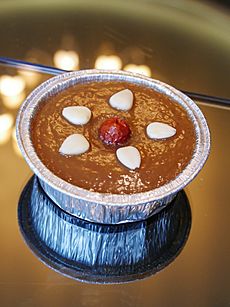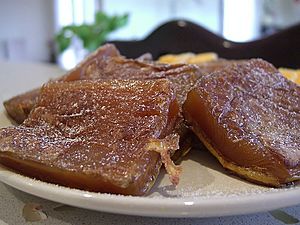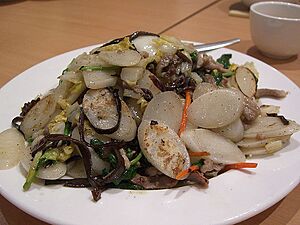Nian gao facts for kids

Cantonese-style nian gao
|
|
| Alternative names | Year cake, Chinese New Year's cake, tikoy, ti kuih |
|---|---|
| Place of origin | China |
| Region or state | East Asia (Mainland China, Hong Kong, Macau, and Taiwan) Southeast Asia (Singapore, Malaysia, Cambodia, Indonesia, Myanmar, Philippines, Thailand and Vietnam) South Asia (Sri Lanka) |
| Variations | Varies by region (Cantonese, Shanghai, Fujian, etc.) |
| Other information | Typically consumed during Chinese New Year |
| Nian gao | |||||||||||||||||
|---|---|---|---|---|---|---|---|---|---|---|---|---|---|---|---|---|---|
| Chinese | 年糕 | ||||||||||||||||
| Literal meaning | year cake | ||||||||||||||||
|
|||||||||||||||||
| Alternative Chinese name | |||||||||||||||||
| Chinese | 甜粿 | ||||||||||||||||
| Literal meaning | sweet kuih | ||||||||||||||||
|
|||||||||||||||||
Nian gao (pronounced "nyen gow") is a special Chinese food. People also call it "year cake" or "New Year cake." It's made from sticky rice flour. You can eat nian gao all year, but it's most popular during the Chinese New Year.
Eating nian gao during New Year is thought to bring good luck. This is because "nian gao" (年糕) sounds like "higher year" (年高). This means you will have a more successful and prosperous year. The word "nian" (年) means "year." The word "gao" (糕) means "cake" and sounds like "gao" (高), which means "tall" or "high."
This sticky, sweet cake was once offered to the Kitchen God. People believed it would make his mouth too sticky to say bad things about the family to the Jade Emperor. It is also eaten during the Duanwu Festival. Nian gao started in China and spread to other Asian countries. This happened because Chinese people traveled and settled in new places.
Contents
History of Nian Gao
The history of making nian gao goes back a long time. People were making it during the Northern and Southern dynasties (386–589 AD). An old farming book called Qimin Yaoshu talks about a recipe for a sticky rice dish. This dish was called ye (䊦).
The recipe described how to make it. You would use sticky rice flour, add water and honey, then knead it. The dough was shaped into squares and sticks. Dates and chestnuts were added. Then, it was steamed with bamboo leaves. This ye was the earliest known type of nian gao.
Why Nian Gao is Special
Nian gao sounds like "higher year" (年高). This means getting promoted or having more success each year. Because of this, nian gao is a popular gift during the New Year. Traditional nian gao is round. It often has a lucky symbol, like the Chinese character for prosperity (福), on top.
People make nian gao into different shapes for gifts. They also use pretty packaging. Popular designs include two carps, which mean "plenty every year." Other designs are gold ingots or the God of Wealth. These designs are lucky symbols. They send good wishes for the New Year.
How Nian Gao is Made
All types of nian gao use glutinous rice. This rice is pounded or ground into a paste. Then, depending on the type, it might be shaped or cooked again. There are many kinds of nian gao. These include types from Cantonese cuisine, Fujian cuisine, Shanghai cuisine, and northern China.
Different Kinds of Nian Gao
Cantonese Nian Gao
The Cantonese type of nian gao is sweet. It usually gets its sweetness from brown sugar. This gives it a dark yellow color. The rice paste is poured into a pan. Then it is steamed until it becomes solid. It is served in thick slices.
You can eat it as it is. It will be very stretchy and sticky. Sometimes, it's served as a pudding. It can be flavored with rosewater or red bean paste. You can also slice it and pan-fry it. Often, it's dipped in egg before frying. This makes "fried nian gao." When fried, it's a little crispy outside but still soft inside.
During Chinese New Year, it's cut into squares. It's served with other cake dishes like water chestnut cakes and taro cakes. People also give nian gao to friends and family. This is a way to wish them good luck and success.
Fujian Nian Gao
In the southern part of Fujian, nian gao is naturally amber in color. It is mainly used for New Year traditions and as gifts. It is made from glutinous rice and taro. People usually slice and cook it before eating. It can also be wrapped in egg or cornstarch and fried.
Shanghai Nian Gao
Nian gao from the Jiangnan region (near the Yangtze River) is white. It has a mild taste. It's made by mixing regular rice with glutinous rice. You can change the amount of each rice to make it softer or firmer.
It can be steamed, fried, or added to soup. Ningbo nian gao is very famous. Common dishes include nian gao in pickled pork soup. Shanghai's ribs nian gao is also well-known. Shanghai-style nian gao is often sold in thick, soft rods. You slice these rods to stir-fry or add to soup. This type is white and made with non-glutinous rice.
Stir-fried nian gao (炒年糕, chǎo nián gāo) is a popular dish. There are three main types. One is savory, with ingredients like scallions, beef, pork, and cabbage. Another is sweet, using white sugar. The last type has almost no taste. People eat it for its chewy texture.
Northern Nian Gao
Northern nian gao can be steamed or fried. It is mostly sweet. In Beijing, it can have jujube and either glutinous rice or yellow rice. There are also mince nian gao and white nian gao.
Shanxi makes nian gao by frying yellow rice. They fill it with red bean paste or jujube paste. Hebei uses jujube, small red beans, and green beans to make steamed nian gao. In Shandong, it's made from red dates and yellow rice. The Northeast type uses beans on sticky sorghum.
Similar Foods in Asia
Many countries in Asia have foods similar to nian gao. This shows how food traditions can spread.
Burma
In Burma, it's called tikay. This name comes from the Hokkien language.
Cambodia
Buddha cake (នំព្រះពុទ្ធ) is like nian gao in Cambodia. People eat it during Khmer New Year.
Indonesia
In Indonesia, it's known as kue keranjang. It's also called dodol Tionghoa, meaning "Chinese dodol." Kue keranjang was originally called nien kao or "yearly cake." This is because it's only made once a year. In East Java, it's called kue keranjang because it's wrapped in a bamboo basket.
Japan
In Japan, mochi is a similar sticky rice cake. It is mainly eaten for the Japanese New Year.
Korea
In Korea, tteokguk is a soup dish. It uses garae-tteok, which is similar to Shanghai nian gao. This soup is traditionally eaten during the Korean New Year.
Peranakan Cuisine
Peranakan Chinese offer steamed sticky cakes called kueh bakul (粘糕; nian gao). They offer these to the Kitchen God, Zao Jun, as gifts.
Philippines
In the Philippines, this food is called tikoy. This name also comes from the Hokkien word for sweet cake. It's popular during the Lunar or Chinese New Year. It became part of Filipino cooking because of trade with Chinese regions.
Tikoy is sweetened with brown sugar, making it dark yellow to light brown. But it can also come in other flavors. For example, ube (purple yam) makes it purple. Pandan makes it green. You can eat tikoy as it is. Or, you can dip it in beaten egg and pan-fry it. This makes it crispy outside but still chewy inside. A version of tikoy in southern Quezon province is sweet and like Japanese mochi. Tikoy can also be used in the Filipino dessert called turon. Or, you can eat it with ice cream, chocolate, or grated coconut and peanuts.
Sri Lanka
In Sri Lanka, seenakku (සීනක්කු) has Malay origins but comes from Chinese influence. Seenakku is a popular sweet among the Sinhalese and Malay people. It is served with grated coconut. The Sri Lankan Malay community calls it cheena kueh, showing its Chinese origin.
Vietnam
Bánh tổ is the Vietnamese version of Chinese nian gao. It is a special food from Quảng Nam province. The ethnic Chinese community in Vietnam also eats it.
Nian Gao Around the World
Nian gao has also spread to countries outside Asia.
Mauritius
In Mauritius, nian gao is often called gâteau la cire. This means "wax cake." It is a traditional cake for the Sino-Mauritian community. Traditionally, it's made with rice flour, sweetened with sugar, and sometimes honey. Orange zest is a key ingredient.
The classic color of nian gao in Mauritius has been brown. But since 2018, new colors and flavors have appeared. These include white (coconut-milk based), green (pandan-based), red, and yellow. In Mauritius, nian gao symbolizes sharing. It's a custom for Sino-Mauritians to share nian gao with family and friends for Chinese New Year. So, people of all backgrounds eat it. Some nian gao is imported, while local Chinese families still make others the traditional way.
United States
Chinese Americans eat cooked or fried nian gao on Chinese New Year's Eve and on New Year's Eve. In Hawai‘i, nian gao is known as gau. It is a popular food eaten during the Chinese New Year.
See also
 In Spanish: Nian gao para niños
In Spanish: Nian gao para niños



